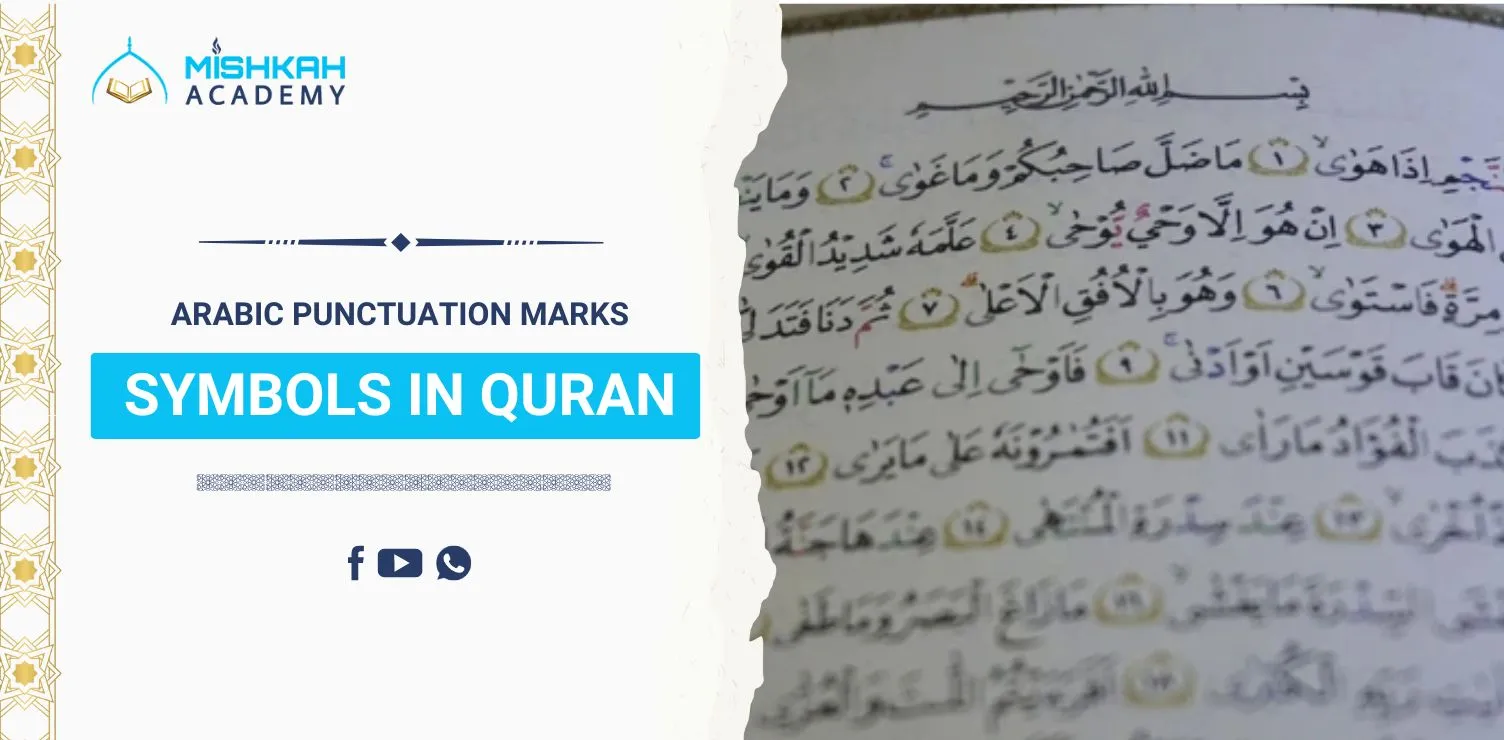The Qur’an, meaning “recitation,” is intended to be recited aloud, with its verses structured to reflect the natural rhythm of the Arabic language. The punctuation in the Qur’an is not solely determined by sentence structure or grammar, but also by the need for pauses—whether to take a breath or to create a particular effect.
Pickthall, a British scholar, writer, and prominent translator of the Qur’an, notes that when a specific sound marking the rhythm is repeated, it prompts a significant pause, often concluding a verse even if the sentence itself continues into the next. This distinctive punctuation, along with tajweed rules, shapes the way words are pronounced, influencing the rhythm, intonation, and separation of syllables.
20 Arabic Punctuation Marks and Symbols in Quran
Table of Contents
ToggleIn this article, we explore 20 key Arabic punctuation marks with symbols used in the Qur’an, shedding light on how each one enhances both the reciter’s experience and the listener’s comprehension of the divine message by following quran reading rules.
1. A large circle ◌
The letter “م” is represented by a small circle, but in the Qur’an, it appears in the shape of the Arabic letter “ḥa” (ح) and is placed above the letter. This prepares the articulation point and allows the sound to be produced clearly, making the letters distinct and audible.
For Example: . أبْ بَ ـ أتْ تَ ـ أثْ ثَ.
2. (مـ)
This symbol indicates the necessity to stop and then begin with what follows, known as “necessary stop” (الوقف اللازم), as seen in the verse of the Almighty
إِنَّمَا يَسْتَجِيبُ الَّذِينَ يَسْمَعُونَ مـ وَالْمَوْتَى يَبْعَثُهُمُ اللَّهُ ﴾ [الأنعام: 36]﴿
3. (لا)
This symbol indicates a prohibition against stopping at its location and also a prohibition against starting recitation with what follows it, as seen in the verse of the Almighty.
ثُمَّ لَا يُتْبِعُونَ مَا أَنْفَقُوا مَنًّا وَلَا أَذًى لا لَهُمْ أَجْرُهُمْ عِنْدَ رَبِّهِمْ ﴾ [البقرة: 262]﴿
3. (صلي)
This symbol indicates that continuing the recitation (connecting the verses) is preferable, although stopping is also permissible, as seen in the verse of the Almighty.
﴾ قُلْ رَبِّي أَعْلَمُ بِعِدَّتِهِمْ مَا يَعْلَمُهُمْ إِلَّا قَلِيلٌ قلي فَلَا تُمَارِ فِيهِمْ ﴿
4. (ج)
This symbol indicates that continuation of recitation is permissible.
وَاعْلَمُوا أَنَّ فِيكُمْ رَسُولَ اللَّهِ ج لَوْ يُطِيعُكُمْ فِي كَثِيرٍ مِنَ الْأَمْرِ لَعَنِتُّمْ ﴾ [الحجرات: 7]﴿
5 . Embracing stop (∴)
This indicates that stopping is permitted at one of the two locations, but not at both, a concept referred to as “the stop of embrace” (وقف المعانقة).
ذَلِكَ الْكِتَابُ لَا رَيْبَ * فِيهِ* هُدًى لِلْمُتَّقِينَ ﴾ [البقرة: 2]﴿
6.( ْ)
This symbol indicates the letter under it is additional and not spoken in Quran recitation.
﴾سَلَاسِلَاْ وَأَغْلَالًا وَسَعِيرًا ﴿
7. (.)
This symbol indicates the letter under it is additional and not spoken in case of wasl or continue recitation
لَكِنَّا هُوَ اللَّهُ ﴾ [الكهف: 38]﴿
8. (•)
To indicate facilitation as in this verse
أَأَعْجَمِيٌّ وَعَرَبِيٌّ ﴾ [فصلت: 44]﴿
9.( ْ )
It indicates this letter is consonant (sakin) and should be pronounced
مَنْ عَمِلَ صَالِحًا فَلِنَفْسِهِ وَمَنْ أَسَاءَ فَعَلَيْهَا وَمَا رَبُّكَ بِظَلَّامٍ لِلْعَبِيدِ ﴾ [فصلت: 46] ﴿
10. (م)
To indicate there is iqlab here . as in this verse:
﴾.عَلِيمٌ م بِذَاتِ الصُّدُورِ﴿
Note: Mishkah Academy online quran recitation course provide instruction on Arabic punctuation marks to their students very deeply.
Book Free Trial Class Now
11.( ً ٌ )
It indicates showing tanween whether it’s fatah or kasar, as in this verse
مَا لَهُمْ بِذَلِكَ مِنْ عِلْمٍ إِنْ هُمْ إِلَّا يَخْرُصُونَ ﴾ [الزخرف: 20]﴿
12. ( ٌ )
For showing tanween by Dumma. for example
فَلَا خَوْفٌ عَلَيْهِمْ وَلَا هُمْ يَحْزَنُونَ ﴾ [البقرة: 38]﴿
13. (ا)، (و)، (ي)
If these letters appear small, they indicate the necessity of pronouncing them as if they were large. Each letter should be articulated according to its formation or lack thereof. An example of this can be found in the elongated “waw in
(داوود)
Also elongated ya can be found in
يُحْيِ ي وَيُمِيتُ
14. (ن)
If the letter “n” appears as a small, solitary character, it signifies the necessity of pronouncing it.
فَاسْتَجَبْنَا لَهُ وَنَجَّيْنَاهُ مِنَ الْغَمِّ ۚ وَكَذَٰلِكَ نُنجِي الْمُؤْمِنِينَ
15. (س)
If the letter “s” (س) appears above the letter “ṣ” (ص), it indicates the necessity of pronouncing the “س This is evident in the following example:
وَاللّهُ يَقْبِضُ وَيَبْصطُ وَإِلَيْهِ تُرْجَعُونَ
If the letter “s” (س) is placed below the letter “ṣ” (ص), it indicates the necessity of pronouncing the ًص.” This is noted in the teachings of Al-Shatibi, as illustrated in the following example
-لَّسْتَ عَلَيْهِم بِمُصَيْطِرٍ
16.( ◊ )
If this mark appears above the letter, it indicates the presence of the ‘Ishmam’.”In Arabic grammar, “Ishmam” refers to a specific phonetic feature related to the pronunciation of certain letters.
قَالُوا يَا أَبَانَا مَا لَكَ لَا تَأْمَنَّا عَلَى يُوسُفَ وَإِنَّا لَهُ لَنَاصِحُونَ ﴾ [يوسف: 11]﴿
17. (◊ )
If this mark appears below the letter, it indicates the presence of ‘Imalah’.00
In Arabic phonetics, “Imalah” refers to a particular pronunciation technique that involves slightly tilting the vowel sound.
18.⃝ – The Conclusion of Verse
“Waqf e Taam” marks the definitive conclusion of a specific verse in the Quran, also referred to as the “Perfect Stop.” It is indicated by a circle at the end of a Quranic line. At this point, the reciter must pause and take a breath before proceeding. This symbol is a key aspect and sign of stopping in quran, as it signifies that the message in the sentence has been fully conveyed. The pause allows the reciter to reflect on the verse, grasp its full meaning, and prepare for the following lines, ensuring a thoughtful and precise recitation.
19. ط – The Absolute Pause
“Waqf e Mutlaq” serves as a stop sign, signaling the reader to pause during the recitation of a lengthy passage. This brief interruption allows the reciter to take a breath and momentarily discontinue reading. Stopping at this point is beneficial, as it facilitates a better understanding of the meaning of the text already recited, making the reading process smoother.
2o. ز – Continue Reading
The “Waqf e Mujawwaz” sign indicates that the reciter can continue without taking a pause, although stopping at this point is permissible.
Conclusion
Arabic punctuation marks in the Quran serve as vital tools for readers, aiding in proper recitation, pauses, pronunciation, and comprehension. From the Full Stop marking the end of sentences to the Mandatory and Discretionary Pauses guiding how to recite, each symbol plays a pivotal role. Even today, these marks remain invaluable in preserving the clarity and accuracy of the Quran’s message, guiding millions in their study and recitation of this arabic text.
Mishkah Academy Quran tutors have shared details about Arabic punctuation marks for students from the UK, USA, Canada, Australia, Germany, and across Europe who want to recite Quran word by word and perfect their Quran recitation. Enroll today in our Quranic Arabic course to understand the Quran word by word and enhance your recitation skills.
Book Free Trial Class Now





